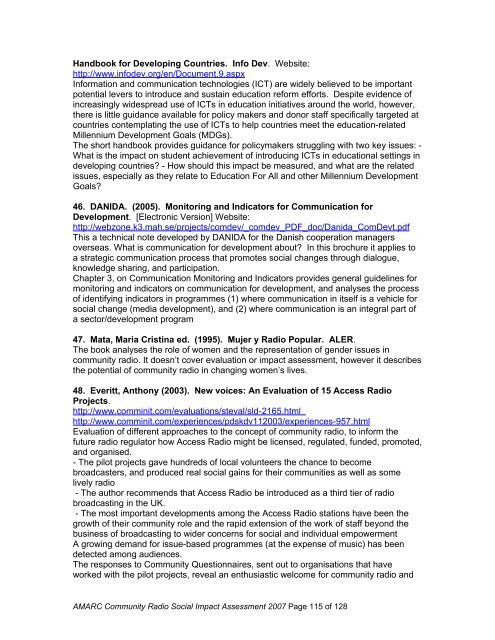Chapter 4, on Indicators and Assessment Methods, includes: Characteristics ofindicators, Describing constituencies, Building impact assessment into informationprojects, Assessing information benefits for organizations, Assessing the impact ofinformation on specific constituencies, Assessing the information richness of theenvironment, Using anecdotes, and Assessing information impact through the market.43. Matewa, Chido E.F. (2002). Media and the empowerment of communities forSocial Change. http://www.comminit.com/evaluations/idmatewa/sld-2241.htmlThe question addressed is to what extent participatory radio production contributes tothe empowerment and advancement of women and the marginalised communities. Italso looks at how community interests, needs and concerns are served by this media.The way traditional media and video are used determines their impact. A process thatenables the target groups to participate in both the production of content anddissemination should be encouraged. This would give communities an opportunity to settheir own agenda as well as enable them to set priorities of what issues are dealt with.The case study of the Development Through Radio Project (DTRP) is based oninformation collected during unstructured in-depth interviews with the project personnel,the founder member, board members, participants of the project, observations of fourradio listeners clubs, articles, documents, annual and general reportsAMARC Africa, Panos Southern Africa, Pronatura-chiapasMexico, and Open SocietyFoundation, South Africa. (2004). Media for Sustainable Development content Survey-A Baseline Study Report on Sustainable Devleopment Content/Themes for CommunityRadio Stations in Africa and Central America.http://www.id21.org/insights/insights58/art08.htmlandhttp://africa.<strong>amarc</strong>.org/files/M4SDStudyMay04l.pdfThe aim of the study was to assess the level at which community radio stations in Africaare involved in programming of content on sustainable development themes/ topics. Thereport finds that "Community radio stations are not doing enough to ensure that localcommunities participate in the selection and production of programmes regardingsustainable development issues, especially in deciding what themes or topics to cover.The focus groups discussions (FGDs) highlighted the potentially significant role thatcommunity media can play in facilitating community and national ownership ofdevelopment agendas, particularly when programming is conducted in local languages.44. Ofir, Zenda ed. (2006). Monitoring and Evaluation. Capacity.Org Issue 29,Sept. 2006. [Electronic Version] Website:http://www.capacity.org/en/content/download/5769/97948/file/EBR+07-29_ENGLISHopmaaK+FINAL_11_Septlowres.pdfThis issue of Capacity.org offers an overview of the different methods and techniquesthat add new dimensions to results-based M&E. Some allow, for example, theobservation of changes over a longer period of time, and offer ways to make suchchanges more tangible. Other innovative forms of M&E can themselves contribute tocapacity building. In this issue, practitioners who have developed such methods describeand explain how they have used them.Includes a number of articles on different approaches to participatory evaluation, such asvideo, for building a shared vision of change. A very useful resource in terms of bringingtogether the ideas of participatory monitoring & evaluation.45. Wagner A. Daniel, Day, Bob, James, Tina, Kozma, Robert B. Miller, Jonathan& Unwin, Tim (2005). Monitoring and Evaluation of ICT in Education Projects: AAMARC Community Radio Social Impact Assessment 2007 Page 114 of 128
Handbook for Developing Countries. Info Dev. Website:http://www.infodev.org/en/Document.9.aspxInformation and communication technologies (ICT) are widely believed to be importantpotential levers to introduce and sustain education reform efforts. Despite evidence ofincreasingly widespread use of ICTs in education initiatives around the world, however,there is little guidance available for policy makers and donor staff specifically targeted atcountries contemplating the use of ICTs to help countries meet the education-relatedMillennium Development Goals (MDGs).The short handbook provides guidance for policymakers struggling with two key issues: -What is the impact on student achievement of introducing ICTs in educational settings indeveloping countries? - How should this impact be measured, and what are the relatedissues, especially as they relate to Education For All and other Millennium DevelopmentGoals?46. DANIDA. (2005). Monitoring and Indicators for Communication forDevelopment. [Electronic Version] Website:http://webzone.k3.mah.se/projects/comdev/_comdev_PDF_doc/Danida_ComDevt.pdfThis a technical note developed by DANIDA for the Danish cooperation managersoverseas. What is communication for development about? In this brochure it applies toa strategic communication process that promotes social changes through dialogue,knowledge sharing, and participation.Chapter 3, on Communication Monitoring and Indicators provides general guidelines formonitoring and indicators on communication for development, and analyses the processof identifying indicators in programmes (1) where communication in itself is a vehicle forsocial change (media development), and (2) where communication is an integral part ofa sector/development program47. Mata, Maria Cristina ed. (1995). Mujer y Radio Popular. ALER.The book analyses the role of women and the representation of gender issues incommunity radio. It doesn’t cover evaluation or impact assessment, however it describesthe potential of community radio in changing women’s lives.48. Everitt, Anthony (2003). New voices: An Evaluation of 15 Access RadioProjects.http://www.comminit.com/evaluations/steval/sld-2165.htmlhttp://www.comminit.com/experiences/pdskdv112003/experiences-957.htmlEvaluation of different approaches to the concept of community radio, to inform thefuture radio regulator how Access Radio might be licensed, regulated, funded, promoted,and organised.- The pilot projects gave hundreds of local volunteers the chance to becomebroadcasters, and produced real social gains for their communities as well as somelively radio- The author recommends that Access Radio be introduced as a third tier of radiobroadcasting in the UK.- The most important developments among the Access Radio stations have been thegrowth of their community role and the rapid extension of the work of staff beyond thebusiness of broadcasting to wider concerns for social and individual empowermentA growing demand for issue-based programmes (at the expense of music) has beendetected among audiences.The responses to Community Questionnaires, sent out to organisations that haveworked with the pilot projects, reveal an enthusiastic welcome for community radio andAMARC Community Radio Social Impact Assessment 2007 Page 115 of 128
- Page 1 and 2:
COMMUNITY RADIOSOCIAL IMPACTASSESSM
- Page 3 and 4:
Chapter 10: Community Media by and
- Page 5 and 6:
ForewordThe World Association of Co
- Page 7 and 8:
monitoring and research process was
- Page 9 and 10:
organizations interviewed tell only
- Page 11 and 12:
The Roundtables, the electronic For
- Page 13 and 14:
good. It did not involve a traditio
- Page 15 and 16:
capabilities for monitoring, impact
- Page 17 and 18:
Each of these components of the ext
- Page 19 and 20:
Description of the ActivitiesThe th
- Page 21 and 22:
PART II. Global Challenges to Commu
- Page 23 and 24:
if we want to achieve poverty reduc
- Page 25 and 26:
Community Radio is part of a politi
- Page 27 and 28:
freedom of expression and military
- Page 29 and 30:
has abandoned those responsibilitie
- Page 31 and 32:
Chapter 5: The Amman Declaration 27
- Page 33 and 34:
10. Independent media can play a si
- Page 35 and 36:
• Promote and support the trainin
- Page 37 and 38:
communication strategies within the
- Page 39 and 40:
This said, it becomes clear that in
- Page 41 and 42:
as rural black women, impoverished
- Page 43 and 44:
national languages. “For several
- Page 45 and 46:
Measuring ImpactChapter 7: The Impa
- Page 47 and 48:
meaningful social change indicator
- Page 49 and 50:
Chapter 8: Why Assess Community Rad
- Page 51 and 52:
doing the work they are chartered t
- Page 53 and 54:
B. Assessing the effectiveness of c
- Page 55 and 56:
• How do you participate in this
- Page 57 and 58:
While community media can take many
- Page 59 and 60:
From this perspective, communicatio
- Page 61 and 62:
affordable means to express their o
- Page 63 and 64: At the same time there is growing r
- Page 65 and 66: Chapter 10: Community Media by and
- Page 67 and 68: Tallies from meetings showed that e
- Page 69 and 70: Chapter 11: What role did community
- Page 71 and 72: RM: [LAUGHS.] So we sang the news,
- Page 73 and 74: commission, tasked with developing
- Page 75 and 76: Most of the Eastern African countri
- Page 77 and 78: need to constantly be guided by ask
- Page 79 and 80: time are settled with custom law, i
- Page 81 and 82: Chapter 14: Community Radio and Med
- Page 83 and 84: ensuing global imbalance in informa
- Page 85 and 86: platforms and technologies? How can
- Page 87 and 88: CR should increase its role in faci
- Page 89 and 90: Clarifying the nature of Community
- Page 91 and 92: Amplify the voices of the poor and
- Page 93 and 94: Harmonize AMARC bodies and structur
- Page 95 and 96: (c) Solidarityactivitiesincludingre
- Page 97 and 98: (d) Interactiveplatform forprogramm
- Page 99 and 100: evaluation(d) Disseminationof resul
- Page 101 and 102: expectations of AMARC relate to all
- Page 103 and 104: Part VI : AnnexesAnnexe 1: Essentia
- Page 105 and 106: One of the chapters is on “Progra
- Page 107 and 108: customs and practices of the tribal
- Page 109 and 110: http://portal.unesco.org/ci/en/file
- Page 111 and 112: Radio Douentza was one of the first
- Page 113: 38. Querre, Francois. (1991). Les M
- Page 117 and 118: The Pelican discussion, which has b
- Page 119 and 120: Through the opinions of 30 communic
- Page 121 and 122: andhttp://www.cfsc.org/pdf/measurin
- Page 123 and 124: www.urcm.netUnited Grassroots Radio
- Page 125 and 126: www.mci.gov.veZimbabwe So this is
- Page 127 and 128: Please indicate how this impact cou
















